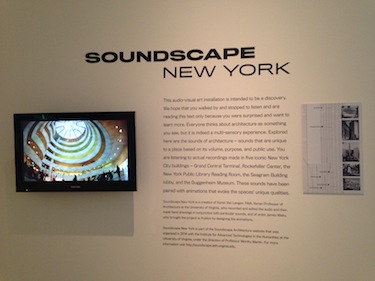Soundscape New York captures the everyday sounds of some of NYC’s greatest landmarks including Grand Central Terminal, Rockefeller Center, the New York Public Library Reading Room, the Seagram Building lobby, and the Guggenheim Museum.
The road to becoming a certified architect is a long one. Like doctors, gaining your master’s degree (yes, master’s) is just step one—you’re required to work alongside certified architects for years to gain the experience and skills necessary to eventually earn your own license, and you still might not pass the series of exams. This process is vital, though. No matter the building, the hope is that the hired architect can create a strong, reliable structure that the client can use everyday.
And what about the aesthetics? It’s just as important to the architect to create a structure that is both functional and beautiful—both outside and in—creating a comfortable space for people to live or pass through.
As a New Yorker, many of the city’s landmarks are more than just fancy buildings. Take Grand Central Station, for example. To me, a stroll through there is enjoyable not just for its appearance, but for the experience—commuters rushing to their jobs, a street performer strumming his guitar, a tour group cheering after a photo was taken. There’s so much more than glass, steel, and stone that make up that building; it’s a living, breathing, multi-sensory hub for life, and vital to the image of New York City.
So where am I going with this? Well, The Museum of the City of New York, located up on Museum Mile (Fifth Avenue and 103rd Street) here in Manhattan, has a small but engrossing exhibit that captures the unique sounds of some of NYC’s greatest buildings—Grand Central Terminal, Rockefeller Center, the New York Public Library Reading Room, the Seagram Building lobby, and the Guggenheim Museum.
With just a pair of small but powerful loudspeakers installed above your head, an Epson projector, and a white wall, this exhibit, called “Soundscape New York,” immerses you in the sounds of these great landmarks, accompanied by animations unique to the sounds. The exhibit’s creator, Karen Van Lengen, FAIA, and Kenan Professor of Architecture at the University of Virginia, recorded and edited everything, and commissioned artist James Welty to design the animations.
Standing under the speakers, you are transported to these other buildings, sensing the size of the room just based on what you hear. The Guggenheim Museum is busy, with the chattering voices of the museum’s thousands of guests echoing across the expansive main lobby. In the Seagram Building, you hear a passing conversation, getting louder and then fading as the moment elapses. The New York Public Library Reading Room, notorious for its silence, instead demonstrated the sounds of books and carts loudly moving around the space. Visually, the animation coincides with the sounds, but if you close your eyes, you can picture the spaces of these buildings as if you were there.



